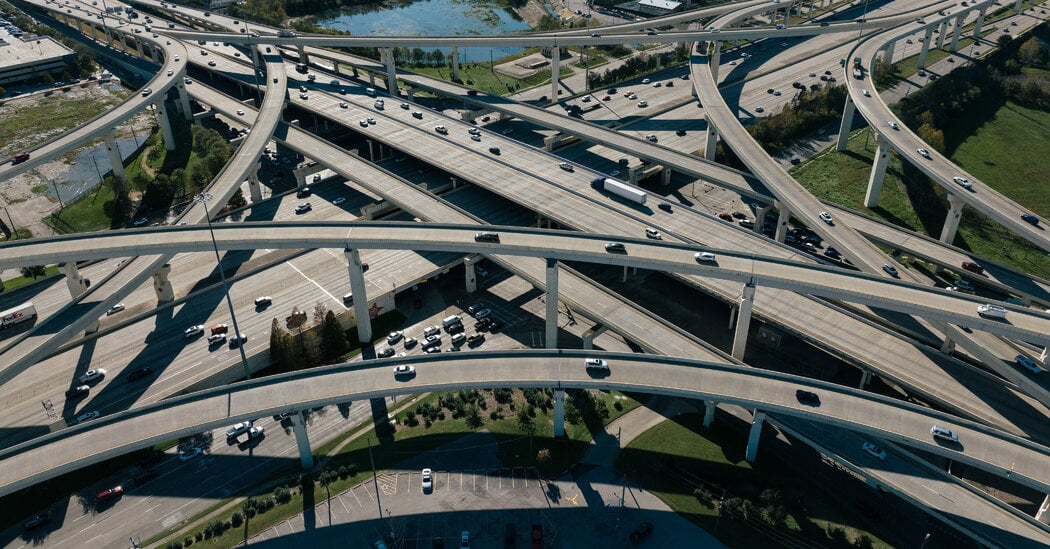For critics of widening projects, the prime example of induced demand is the Katy Freeway in Houston, one of the widest highways in the world with 26 lanes.
Immediately after Katy’s last expansion, in 2008, the project was hailed as a success. But within five years, peak hour travel times on the freeway were longer than before the expansion.
Matt Turner, an economics professor at Brown University and co-author of the 2009 study on congestion, said adding lanes is a fine solution if the goal is to get more cars on the road. But most highway expansion projects, including those in progress in Texas, cite reducing traffic as a primary goal.
“If you keep adding lanes because you want to reduce traffic congestion, you have to be really determined not to learn from history,” Dr. Turner said.



But think of the alternative. In Japan the trains arrive every 10 minutes are publicity subsidized so cost is minimal and because of this there exists an entire generation of train nerds that just want to go out and photograph trains. Are you gonna let the nerds win?
Can’t let a bunch of train virgins take away my Ford F-750.
12 yards long, 2 lanes wide,
65 tons of American Pride!
Canyonero! Canyonero!
It’s getting to the point where that isn’t exaggerating all that much.
Those train nerds are super cool. James may talked to a couple of them that had memorized every station’s unique arrival jingle and message and the one guy could whistle them. They said they weren’t popular with the ladies but i don’t understand how with cool skills/knowledge like that
I’m all for trains and against cars, but is Japan really the best example? Don’t they have people stuffing passengers into cars with special passenger packing sticks?
In Tokyo there are 20 million people
The yamanote line at peak hour has a lot of folks, it’s true
But if these 20 million people were in cars? My friend the entire city would be a gigantic 100 lane highway and things would be significantly shittier I guarantee
Trains are the solution and america is insane for ripping up lines to force people to buy cars
100 lanes sounds like a massive exaggeration but is actually undercutting it lol. It’s insane how space and energy inefficient it is to transport that many people in individual cars.
The yamenote line transports 5 million people a day
The Katy Freeway transports 219 000 cars. Let’s say that’s 400 000 people. (pretty generous I think, most cars are just one guy driving to work)
You would need 5 million / 400 000 = 12.5 Katy freeways.
That would be 12.5*26 lanes =325 lanes!
Absolutely true. The amount of land required for not only all the damn traffic, but parking as well. Cars do not make any sense. I can see individual battery assist bikes and scooters but cars in a city are just stupid. And don’t get me started on the colossal idiocy of Musks ‘hyperloop’
I was there as a tourist this summer and it was fine overall. Middle of the day there were often lots of seats open but early morning or around 6 you had to stand but it wasnt bad at all. No pushing or anything.
The Tokyo metro system is amazing, I rode like 50 trains all over the city the entire day, and it was really pleasant the entire time
And housing is still affordable because they control zoning at the federal level and build houses to meet demand.
Whut? Everything I’ve read about housing in Japan (which admittedly is little) tell me housing is super expensive.
If I had to guess (and this is definitely a guess), it’s that Japan is cheap … for the population density compared to other major cities across the world. So, cheap compared to places that still look like a ripoff to anyone living rural.
Or comparing square footage. Japanese people are far more space efficient than dumbass McMansions.
If you have to make apartments shoebox sized so people can afford it, that’s not a sign that it’s affordable. Also, there is normal sized housing in suburbs / rural areas there. It’s like they will choose to live like humans given the chance, and not sardines in a can.
Would you rather have a shoe box or hundreds of homeless people in every city?
Besides, no one is saying they HAVE to be small here. Japan has a much, much higher density to support.
That’s a false dichotomy. I want affordable housing everywhere. How about that?
Texas is around 700000 sq km with 30 million people, whereas Japan is 400000 sq km with 125 million people. The demands for space are very different between the two places and their respective urban areas. Costs are always higher in dense cities, but the links up above seem to suggest that they haven’t ballooned as much in Japan. Space constraints of urban regions will also obviously lead to less space per person, for those who want to live there. With finite space, you have to compromise on size or on cost. I think the poster above is simply stating that fact with the “homeless or small space” dichotomy, though I think that is maybe a bit hyperbolic.
https://www.wsj.com/articles/what-housing-crisis-in-japan-home-prices-stay-flat-11554210002
https://thinkrealstate.com/why-are-houses-in-japan-so-cheap/
https://marketurbanism.com/2019/03/19/why-is-japanese-zoning-more-liberal-than-us-zoning/
They are cheap compared to other major cities. It is because of vastly different zoning laws that limit sprawl (they do not have a lot of excess land) and stops NIMBY issue. They keep building to match demand.